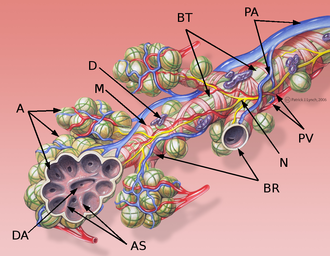Septum
<languages /><translate>
- See Ceuta#History for the city in Roman Mauretania.
In anatomy, a septum (Latin for something that encloses; plural septa) is a wall, dividing a cavity or structure into smaller ones.
Examples[edit]
In human anatomy[edit]
- Interatrial septum, the wall of tissue that is a sectional part of the left and right atria of the heart
- Interventricular septum, the wall separating the left and right ventricles of the heart
- Lingual septum, a vertical layer of fibrous tissue that separates the halves of the tongue
- Nasal septum: the cartilage wall separating the nostrils of the nose

- Alveolar septum: the thin wall which separates the alveoli from each other in the lungs
- Orbital septum, a palpabral ligament in the upper and lower eyelids
- Septum pellucidum or septum lucidum, a thin structure separating two fluid pockets in the brain
- Medial septum, a cluster of neurons in close proximity to the septum pellucidum
- Uterine septum, a malformation of the uterus
- Vaginal septum, a lateral or transverse partition inside the vagina
Histological septa are seen throughout most tissues of the body, particularly where they are needed to stiffen soft cellular tissue, and they also provide planes of ingress for small blood vessels. Because the dense collagen fibres of a septum usually extend out into the softer adjacent tissues, microscopic fibrous septa are less clearly defined than the macroscopic types of septa listed above. In rare instances, a septum is a cross-wall. Thus it divides a structure into smaller parts.
In zoology[edit]
- One of the radial calcareous plates of a coral. b. One of the transverse partitions dividing the shell of a mollusk, or of a rhizopod, into several chambers. c. One of the transverse partitions dividing the body cavity of an annelid.
- Septum (marine biology): walls between each chamber, or siphuncle, in shells of nautiloids, ammonites, and belemnites; i.e. cephalopods that retain an external shell.
In mycology[edit]
- A partition dividing filamentous hyphae into discrete cells in fungi
In botany[edit]
- A partition that separates the locules of a fruit, anther, or sporangium.</translate>
Septum[edit]
-
Ventricular septal defect
-
Tongue
-
Bronchial anatomy
-
S. cerevisiae septins
-
Septate hyphae of Alternaria sp.
-
Kumato
Ad. Transform your life with W8MD's Budget GLP-1 injections from $75


W8MD offers a medical weight loss program to lose weight in Philadelphia. Our physician-supervised medical weight loss provides:
- Weight loss injections in NYC (generic and brand names):
- Zepbound / Mounjaro, Wegovy / Ozempic, Saxenda
- Most insurances accepted or discounted self-pay rates. We will obtain insurance prior authorizations if needed.
- Generic GLP1 weight loss injections from $75 for the starting dose.
- Also offer prescription weight loss medications including Phentermine, Qsymia, Diethylpropion, Contrave etc.
NYC weight loss doctor appointmentsNYC weight loss doctor appointments
Start your NYC weight loss journey today at our NYC medical weight loss and Philadelphia medical weight loss clinics.
- Call 718-946-5500 to lose weight in NYC or for medical weight loss in Philadelphia 215-676-2334.
- Tags:NYC medical weight loss, Philadelphia lose weight Zepbound NYC, Budget GLP1 weight loss injections, Wegovy Philadelphia, Wegovy NYC, Philadelphia medical weight loss, Brookly weight loss and Wegovy NYC
|
WikiMD's Wellness Encyclopedia |
| Let Food Be Thy Medicine Medicine Thy Food - Hippocrates |
Medical Disclaimer: WikiMD is not a substitute for professional medical advice. The information on WikiMD is provided as an information resource only, may be incorrect, outdated or misleading, and is not to be used or relied on for any diagnostic or treatment purposes. Please consult your health care provider before making any healthcare decisions or for guidance about a specific medical condition. WikiMD expressly disclaims responsibility, and shall have no liability, for any damages, loss, injury, or liability whatsoever suffered as a result of your reliance on the information contained in this site. By visiting this site you agree to the foregoing terms and conditions, which may from time to time be changed or supplemented by WikiMD. If you do not agree to the foregoing terms and conditions, you should not enter or use this site. See full disclaimer.
Credits:Most images are courtesy of Wikimedia commons, and templates, categories Wikipedia, licensed under CC BY SA or similar.
Translate this page: - East Asian
中文,
日本,
한국어,
South Asian
हिन्दी,
தமிழ்,
తెలుగు,
Urdu,
ಕನ್ನಡ,
Southeast Asian
Indonesian,
Vietnamese,
Thai,
မြန်မာဘာသာ,
বাংলা
European
español,
Deutsch,
français,
Greek,
português do Brasil,
polski,
română,
русский,
Nederlands,
norsk,
svenska,
suomi,
Italian
Middle Eastern & African
عربى,
Turkish,
Persian,
Hebrew,
Afrikaans,
isiZulu,
Kiswahili,
Other
Bulgarian,
Hungarian,
Czech,
Swedish,
മലയാളം,
मराठी,
ਪੰਜਾਬੀ,
ગુજરાતી,
Portuguese,
Ukrainian





